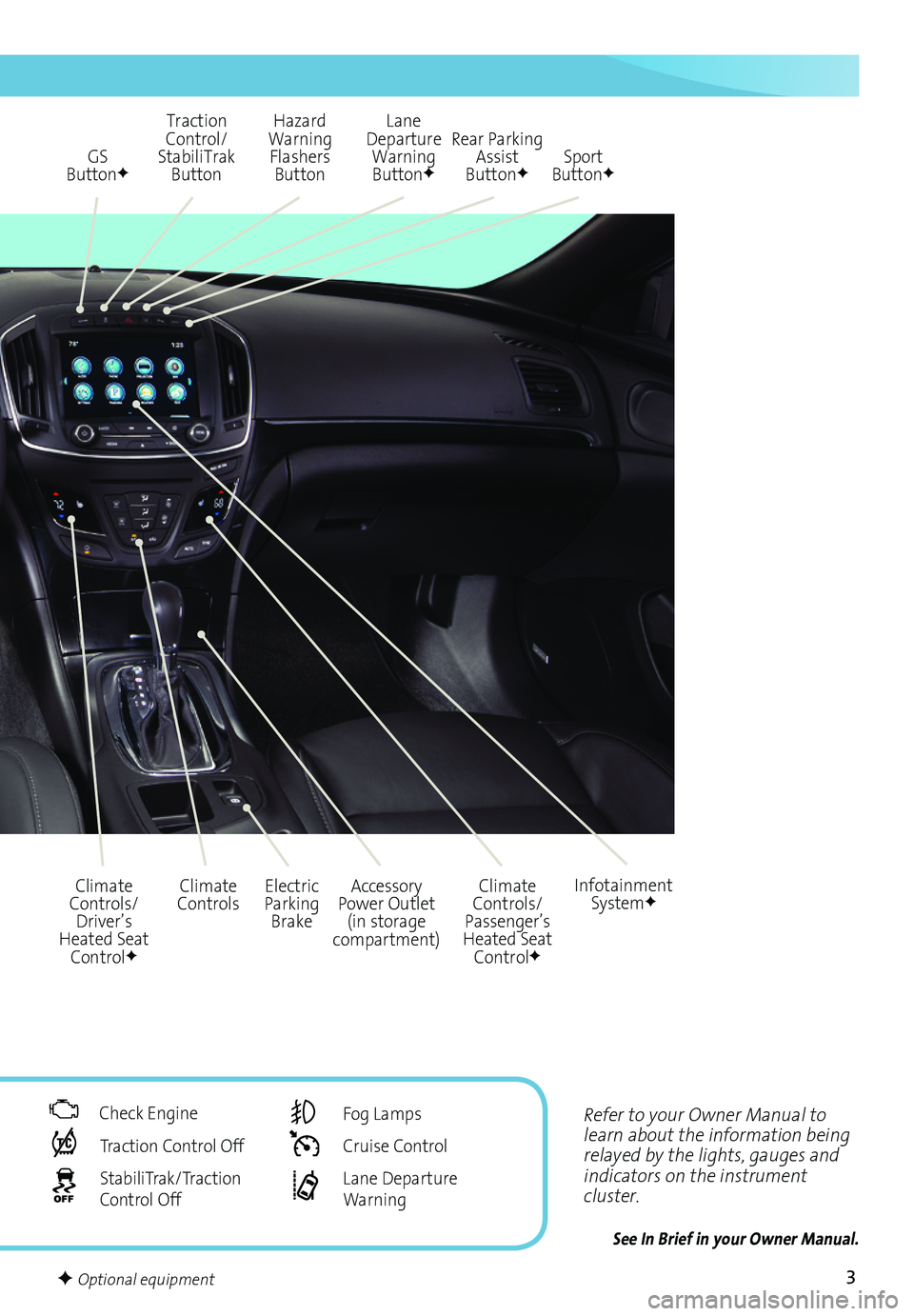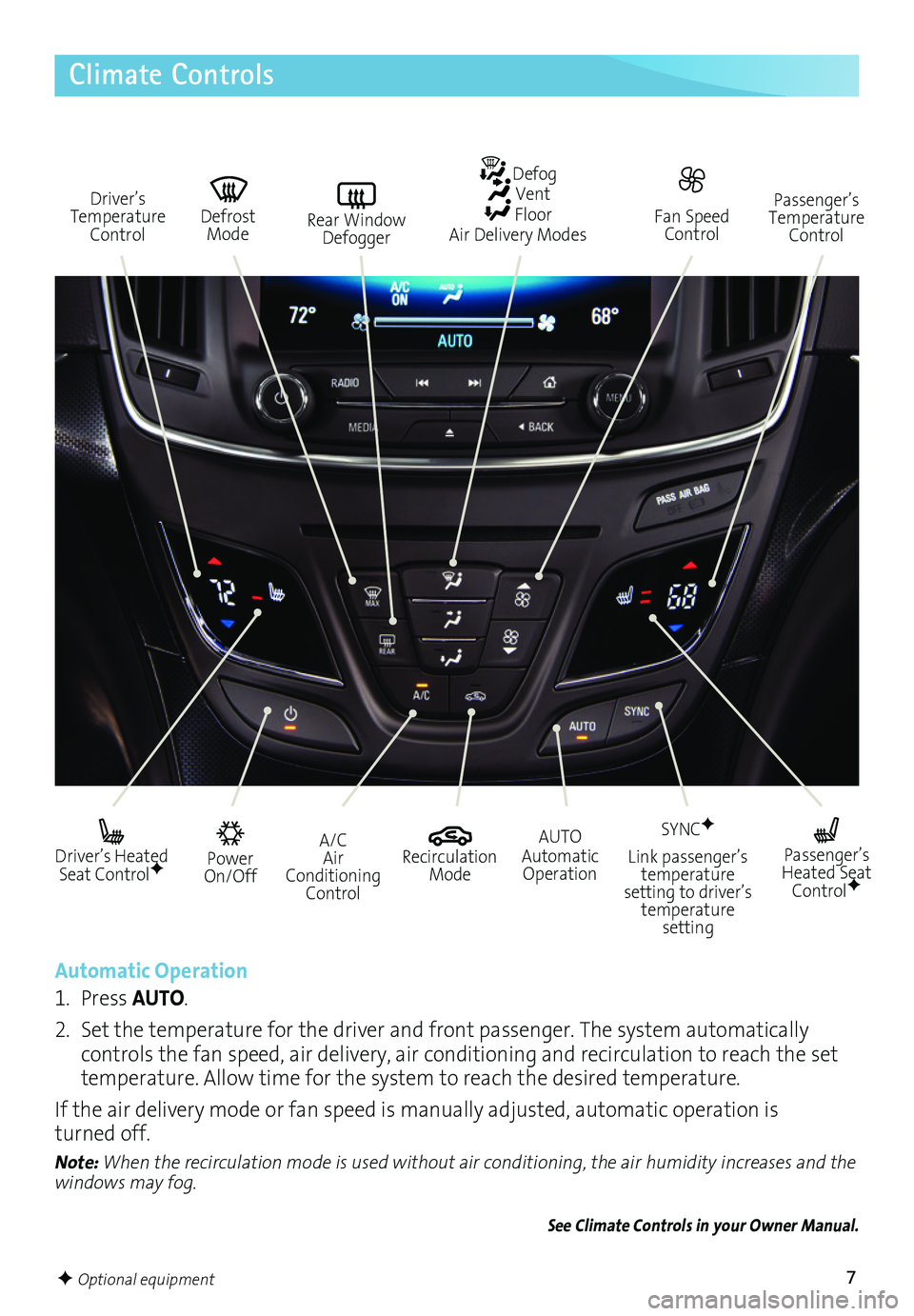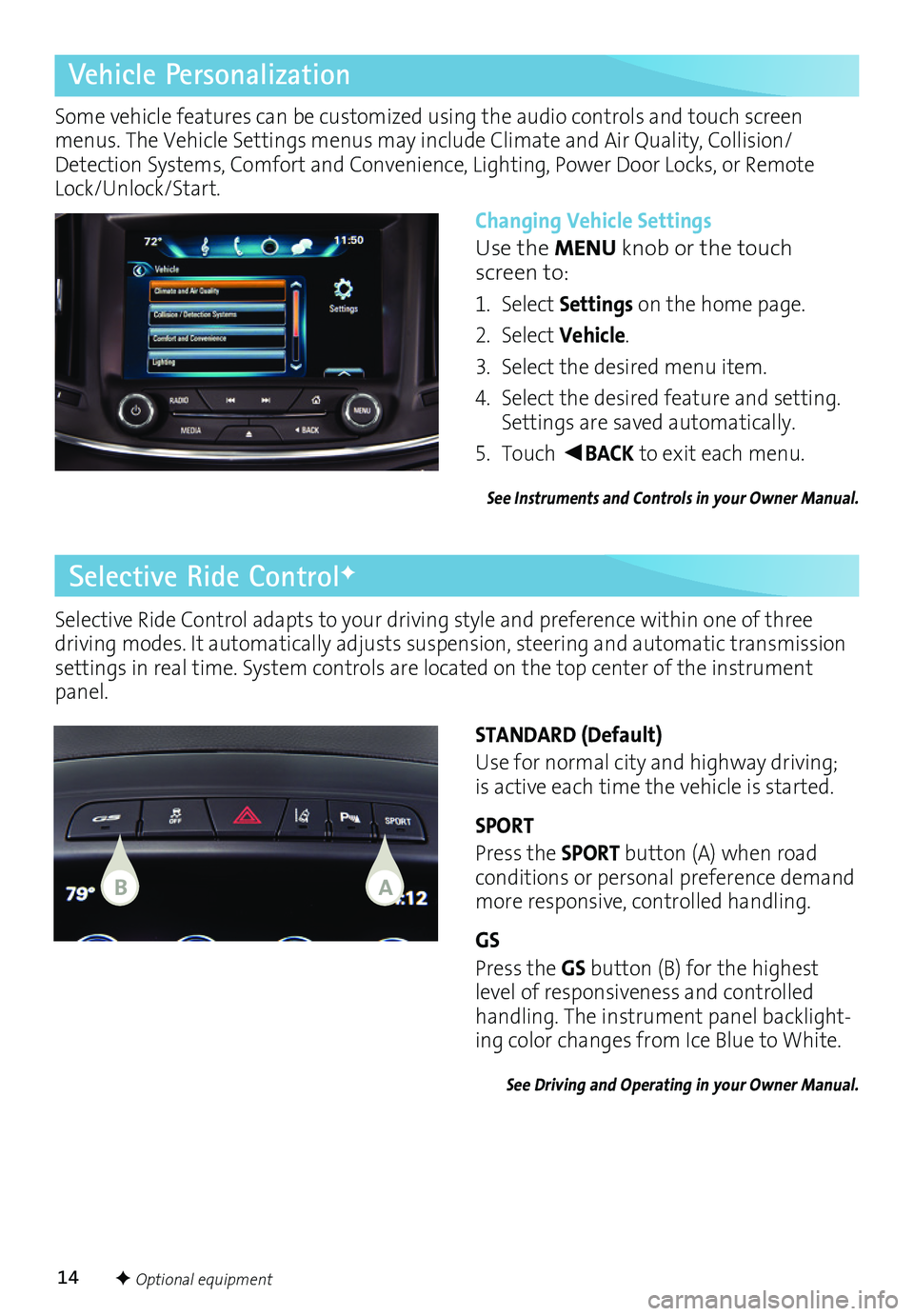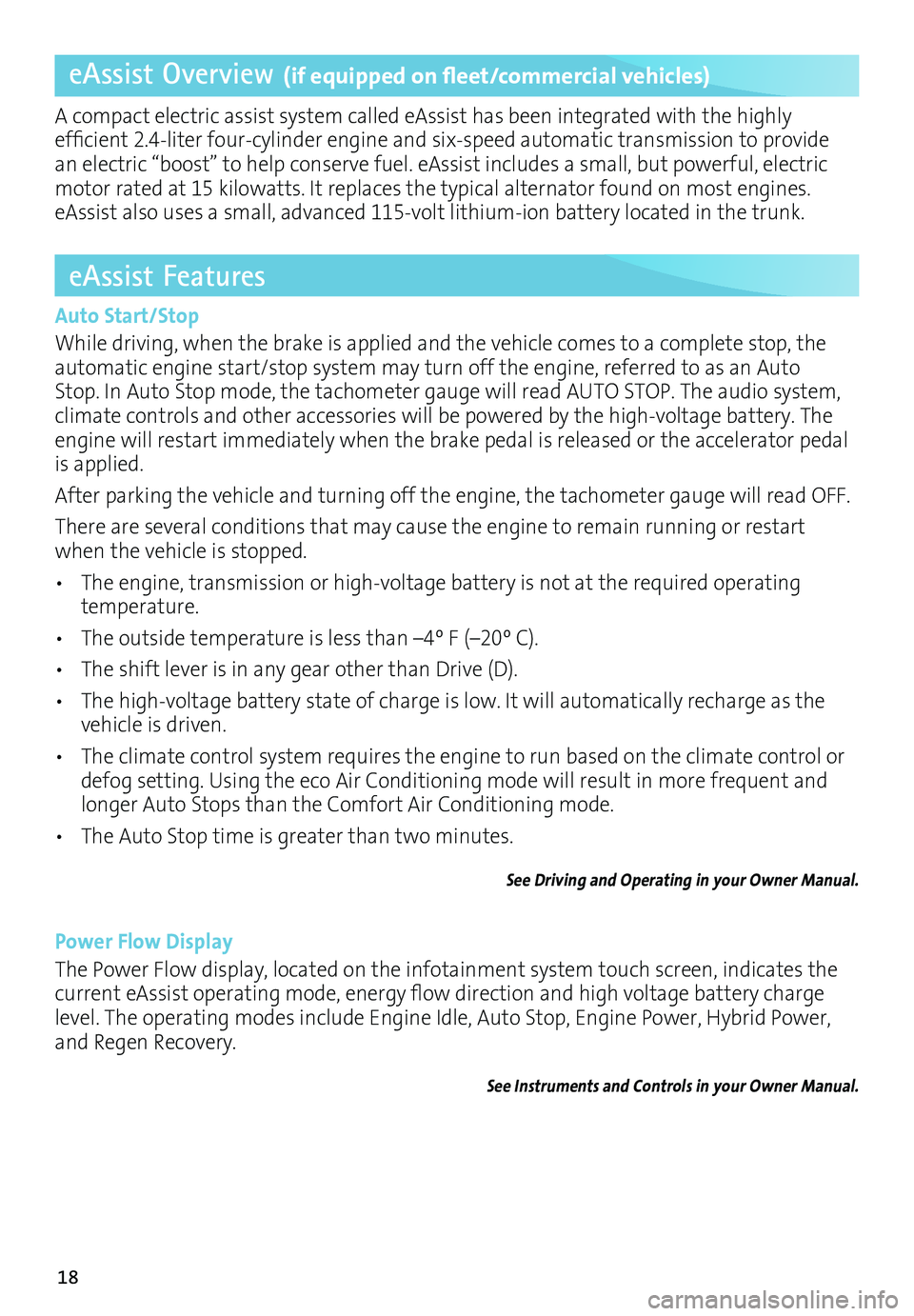climate control BUICK REGAL 2016 Get To Know Guide
[x] Cancel search | Manufacturer: BUICK, Model Year: 2016, Model line: REGAL, Model: BUICK REGAL 2016Pages: 20, PDF Size: 2.64 MB
Page 3 of 20

3
Refer to your Owner Manual to learn about the information being relayed by the lights, gauges and indicators on the instrument cluster.
See In Brief in your Owner Manual.
GS ButtonF
Accessory Power Outlet (in storage compartment)
Climate ControlsElectric Parking Brake
Climate Controls/Passenger’s Heated Seat ControlF
Infotainment SystemF
Traction Control/ StabiliTrak Button
Hazard Warning Flashers Button
Climate Controls/Driver’s Heated Seat ControlF
Rear Parking Assist ButtonF
Lane Departure Warning ButtonFSport ButtonF
Check Engine
Traction Control Off
StabiliTrak/Traction Control Off
Fog Lamps
Cruise Control
Lane Departure Warning
F Optional equipment
Page 7 of 20

7
Climate Controls
A/C Air Conditioning Control
Power On/Off
Driver’s Temperature Control
Driver’s Heated Seat ControlF
Recirculation Mode
Fan Speed Control
AUTO Automatic Operation
Defrost Mode
SYNCF
Link passenger’s temperature setting to driver’s temperature setting
Rear Window Defogger
Automatic Operation
1. Press AUTO.
2. Set the temperature for the driver and front passenger. The system automatically
controls the fan speed, air delivery, air conditioning and recirculation to reach the set temperature. Allow time for the system to reach the desired temperature.
If the air delivery mode or fan speed is manually adjusted, automatic operation is turned off.
Note: When the recirculation mode is used without air conditioning, the air humidity increases and the windows may fog.
Passenger’s Heated Seat ControlF
Passenger’s Temperature Control
See Climate Controls in your Owner Manual.
Defog Vent Floor Air Delivery Modes
F Optional equipment
Page 14 of 20

14
Selective Ride Control adapts to your driving style and preference within one of three
driving modes. It automatically adjusts suspension, steering and automatic transmission settings in real time. System controls are located on the top center of the instrument panel.
Selective Ride ControlF
STANDARD (Default)
Use for normal city and highway driving; is active each time the vehicle is started.
SPORT
Press the SPORT button (A) when road
conditions or personal preference demand more responsive, controlled handling.
GS
Press the GS button (B) for the highest level of responsiveness and controlled handling. The instrument panel backlight-ing color changes from Ice Blue to White.
See Driving and Operating in your Owner Manual.
Some vehicle features can be customized using the audio controls and touch screen menus. The Vehicle Settings menus may include Climate and Air Quality, Collision/Detection Systems, Comfort and Convenience, Lighting, Power Door Locks, or Remote Lock/Unlock/Start.
Vehicle Personalization
Changing Vehicle Settings
Use the MENU knob or the touch screen to:
1. Select Settings on the home page.
2. Select Vehicle.
3. Select the desired menu item.
4. Select the desired feature and setting. Settings are saved automatically.
5. Touch ◄BACK to exit each menu.
See Instruments and Controls in your Owner Manual.
F Optional equipment
BA
Page 18 of 20

18
eAssist Overview (if equipped on fleet/commercial vehicles)
A compact electric assist system called eAssist has been integrated with the highly efficient 2.4-liter four-cylinder engine and six-speed automatic transmission to provide an electric “boost” to help conserve fuel. eAssist includes a small, but powerful, electric motor rated at 15 kilowatts. It replaces the typical alternator found on most engines.
eAssist also uses a small, advanced 115-volt lithium-ion battery located in the trunk.
eAssist Features
Auto Start/Stop
While driving, when the brake is applied and the vehicle comes to a complete stop, the automatic engine start/stop system may turn off the engine, referred to as an Auto Stop. In Auto Stop mode, the tachometer gauge will read AUTO STOP. The audio system, climate controls and other accessories will be powered by the high-voltage battery. The engine will restart immediately when the brake pedal is released or the accelerator pedal is applied.
After parking the vehicle and turning off the engine, the tachometer gauge will read OFF.
There are several conditions that may cause the engine to remain running or restart when the vehicle is stopped.
• The engine, transmission or high-voltage battery is not at the required operating temperature.
• The outside temperature is less than –4º F (–20º C).
• The shift lever is in any gear other than Drive (D).
• The high-voltage battery state of charge is low. It will automatically recharge as the vehicle is driven.
• The climate control system requires the engine to run based on the climate control or defog setting. Using the eco Air Conditioning mode will result in more frequent and
longer Auto Stops than the Comfort Air Conditioning mode.
• The Auto Stop time is greater than two minutes.
See Driving and Operating in your Owner Manual.
Power Flow Display
The Power Flow display, located on the infotainment system touch screen, indicates the current eAssist operating mode, energy flow direction and high voltage battery charge level. The operating modes include Engine Idle, Auto Stop, Engine Power, Hybrid Power, and Regen Recovery.
See Instruments and Controls in your Owner Manual.
Page 19 of 20

19
Driver Efficiency Gauge
The driver efficiency gauge, located on the instrument cluster, assists you in driving
efficiently. To maximize efficiency, attempt to keep the pointer in the solid green zone in the middle of the gauge. The gauge moves down when braking and up when accelerating or driving at high speeds. When
driving aggressively, it is less efficient and the gauge will move farther away from center. The eAssist system’s ability to capture energy while the vehicle is slowing down makes decelerating important for vehicle efficiency.
See Instruments and Controls in your Owner Manual.
Climate Control Settings
Press the A/C button twice to select the eco Air Conditioning setting (green A/C indica-tor) for maximum efficiency. This setting will maximize the frequency and duration of Auto Stops while still providing cabin comfort when the vehicle is in an Auto Stop. To
further maximize efficiency, operate the climate controls in the Automatic mode at the
highest comfortable temperature setting or turn off the air conditioning system when climate conditions allow.
Select the Comfort Air Conditioning setting (amber A/C indicator) for maximum cabin
comfort. Auto Stops will be reduced in both frequency and duration.
See Climate Controls in your Owner Manual.
Regenerative Braking
When braking or coasting, the electric motor acts like a generator to charge the high-voltage battery. This “regenerative braking” process captures kinetic energy that would otherwise be lost and stores it in the high-voltage battery. This electrical energy can then be reused.
Note: Capturing kinetic energy causes transmission shifts that have more feel when braking or coasting.
See In Brief in your Owner Manual.
Next Generation Transmission
The eAssist system employs a next generation six-speed transmission with sophisticated algorithms that continuously store information about your driving style, such as accelera-tion and braking. Over the first 250–400 miles, some transmission shifts may be more noticeable. As the vehicle is driven in a variety of city and highway driving conditions,
eAssist will use its on-board processing power to quickly “learn” your driving habits in order to deliver a seamless driving experience.
See Driving and Operating in your Owner Manual.
Hill Start Assist
After stopping on an incline, the Hill Start Assist feature momentarily holds the vehicle when the brake pedal is released. The driver-applied brake pressure is used during the stop to keep the vehicle from rolling during the period between when the brake pedal is released and the accelerator pedal is applied.
See Driving and Operating in your Owner Manual.
eAssist Features